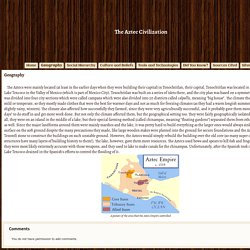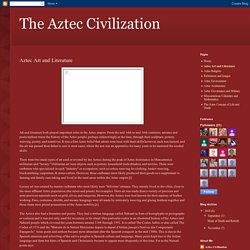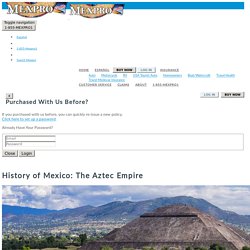

Aztecs: Empire, Culture & Facts. The Aztecs, who probably originated as a nomadic tribe in northern Mexico, arrived in Mesoamerica around the beginning of the 13th century.

From their magnificent capital city, Tenochtitlan, the Aztecs emerged as the dominant force in central Mexico, developing an intricate social, political, religious and commercial organization that brought many of the region’s city-states under their control by the 15th century. Invaders led by the Spanish conquistador Hernán Cortés overthrew the Aztec Empire by force and captured Tenochtitlan in 1521, bringing an end to Mesoamerica’s last great native civilization. Early Aztec History. Facts, Location, & Culture. Aztec, self name Culhua-Mexica, Nahuatl-speaking people who in the 15th and early 16th centuries ruled a large empire in what is now central and southern Mexico.

The Aztecs are so called from Aztlán (“White Land”), an allusion to their origins, probably in northern Mexico. They were also called the Tenochca, from an eponymous ancestor, Tenoch, and the Mexica, probably from Metzliapán (“Moon Lake”), the mystical name for Lake Texcoco. Aztec Mythology – Mythopedia. Geography - The Aztec Civilization. The Aztecs were mainly located (at least in the earlier days when they were building their capital) in Tenochtitlan, their capital.

Tenochtitlan was located in an island on Lake Texcoco in the Valley of Mexico (which is part of Mexico City). Tenochtitlan was built on a series of islets there, and the city plan was based on a symmetrical layout that was divided into four city sections which were called campans which were also divided into 20 districts called calpullis, meaning "big house". The climate there was mainly mild or temperate, so they mostly made clothes that were the best for warmer days and not as much for freezing climates (as they had a warm longish summer and short, slightly rainy, winters). The climate also affected how successfully they farmed, since they were very agriculturally successful, and it probably gave them more suitable "good days" to do stuff in and get more work done. But not only the climate affected them, but the geographical setting too. Uto-Aztecan language. Nahuatl language, Spanish náhuatl, Nahuatl also spelled Nawatl, also called Aztec, American Indian language of the Uto-Aztecan family, spoken in central and western Mexico.

Nahuatl, the most important of the Uto-Aztecan languages, was the language of the Aztec and Toltec civilizations of Mexico. A large body of literature in Nahuatl, produced by the Aztecs, survives from the 16th century, recorded in an orthography that was introduced by Spanish priests and based on that of Spanish. The phonology of Classical Nahuatl, the language of the Aztecs, was notable for its use of a tl sound produced as a single consonant and for the use of the glottal stop. The glottal stop has been lost in some modern dialects—replaced by h—and retained in others. Aztec Empire for Kids: Government and Empire. National Geographic Society. The legendary origin of the Aztec people has them migrating from a homeland called Aztlan to what would become modern-day Mexico.

While it is not clear where Aztlan was, a number of scholars believe that the Mexica—as the Aztec referred to themselves—migrated south to central Mexico in the 13th century. The Mexica founding of Tenochtitlan was under direction from their patron god Huitzilopochtli, according to legend. The legend recounts that Huitzilopochtli told them to found their settlement in the place where a giant eagle eating a snake was perched on a cactus. This settlement, in the region of Mesoamerica called Anáhuac located on a group of five connected lakes, became Tenochtitlan. Archaeologists date the founding of Tenochtitlan to 1325 C.E. Mexicolore. Question for December 2010 Did they have the same seasons as we do?

Asked by City of London Freemen’s School. Chosen and answered by Our In-House Team. Aztec Religion - History Crunch - History Articles, Summaries, Biographies, Resources and More. The Aztecs ruled over a powerful empire throughout much of central Mexico in the centuries before the arrival of Spanish conquistadors during the European Age of Exploration.

An important aspect of the Aztec Empire and history was their religious beliefs and practices. In general, the Aztecs shared many of their main religious beliefs and practices with other societies in the region. For example, some gods and religious practices were common throughout different Mesoamerican societies, including: Toltec and Teotihuacan. As such, when learning about Aztec religion it’s important to understand that much of it also applies to other civilizations throughout the history of the region.
Aztec Government - History Crunch - History Articles, Summaries, Biographies, Resources and More. Aztec Civilization. The Aztec Empire flourished between c. 1345 and 1521 CE and, at its greatest extent, covered most of northern Mesoamerica. Aztec warriors were able to dominate their neighbouring states and permit rulers such as Motecuhzoma II to impose Aztec ideals and religion across Mexico. Highly accomplished in agriculture and trade, the last of the great Mesoamerican civilizations was also noted for its art and architecture which ranks amongst the finest ever produced on the continent.
The Aztec state is actually the most well-documented Mesoamerican civilization with sources including archaeology, native books (codices) and lengthy and detailed accounts from their Spanish conquerors - both by military men and Christian clergy. Historical Overview Sometime around 1100 CE the city-states or altepetl which were spread over central Mexico began to compete with each other for local resources and regional dominance. The Aztec Civilization: Aztec Art and Literature. Art and literature both played important roles in the Aztec empire.

From the mid 14th to mid 16th centuries, artisans and poets/authors wrote the history of the Aztec people, perhaps unknowingly at the time, through their sculpture, pottery, weaving, poetry, and narratives. It was a firm Aztec belief that artists were born with their skills however, each was trained, and the art was passed from father to son in most cases, where the son was an apprentice for many years as he mastered the needed skills. There were two main types of art used or revered by the Aztecs during the peak of Aztec dominance in Mesoamerica: utilitarian and "luxury. " Utilitarian art were objects such as pottery, household tools (blades), and textiles.
Aztec music. The importance of Aztec music in the lives of the citizens of the empire is hinted at in this quote from Spanish friar Gerónimo de Mendieta: Each lord had in his house a chapel with composer-singers of dances and songs, and these were thought to be ingenious in knowing how to compose the songs in their manner of meter and the couplets that they had.

Ordinarily they sang and danced in the principal festivities that were every twenty days, and also on other less principal occasions... Aztec music was a constant and important part of life. History of Mexico The Aztec Empire. By Roxanna Brock McDade The Aztec Empire was an ancient civilization located in the Valley of Mexico hundreds of years ago.

We've uncovered incredible relics from this advanced society, and through these, we have learned about their amazing 300-year existence. Exploring Aztec culture is one major reason for tourism in Mexico, as people look to get an up-close view of what the civilization left behind. Aztecs Recipes. Aztec Empire: Everyday Foods and Feasts. Most of daily life in the Aztec Empire depended on a person’s social status, whether they were a member of the nobility or of the commons. That status determined what people ate, what they wore, their style of house and their occupation. The Aztecs were an agriculturally-based society and most spent their days working their fields and gardens or otherwise participating in cultivating food for their great city of Tenochtitlan. Maize or corn was the dominant staple crop of the Aztecs and other Mesoamerican cultures.
Maize could grow nearly everywhere except on mountains. As the dominant staple, corn was eaten every day in different forms. Aztec commoners ate a predominantly vegetarian diet, occasionally flavored with meat or fish. Aztec Education: Learning at Home and School. Aztec education was quite sophisticated compared to contemporary empires in the Eastern and Western Hemispheres. The Aztec Empire is one of the few older civilizations that featured mandatory education at home and in schools. Every child was educated, no matter his or her social status, whether noble, commoner or slave. Two different schools taught the young—one for the noble class and one for commoners, although bright, talented commoners might be chosen for advanced learning at the noble school.
Children’s Aztec education, however, started at home with their parents. From age four or five, boys learned and worked with their fathers at a trade or craft, farming, hunting and fishing. All children were taught a large collection of sayings called the huehuetlatolli, which incorporated Aztec ideas and teachings. For the first 14 years of life, boys and girls were taught at home by their parents. Aztec Education: Calmecac Aztec Education: Telpochcalli Cite This Article.
Aztec Family Law - Exhibit - Aztec and Maya Law - Tarlton Law Library at Tarlton Law Library. Aztec communication and literature. Origins of Language Nahuatl (Nahuatl pronunciation: [ˈnaː.watɬ] , with stress on the first syllable) is a group of related languages and dialects of the Nahuan (traditionally called “Aztecan“) branch of the Uto-Aztecan language family. Collectively they are spoken by an estimated 1.5 million Nahua people, most of whom live in Central Mexico.
All Nahuan languages are indigenous to Mesoamerica. Nahuatl Dialects Map, where Nahuatl is spoken today. Nahuatl has been spoken in Central Mexico since at least the 7th century AD. The Top 10 Aztec Gods of Mexica Mythology. Aztec deity. Sexuality In The Aztec Empire Was Actually Even More Repressed Than Puritan England. Aztec-Emperors Picture. Important Aztecs - The Aztecs. Acamapichtli was the first Great Emperor of the Aztec people. He ruled from 1376 to 1396. Although his reign was short but he did a lot in a short period. Untitled. Aztec Sacrifice - The Meaning of Ritual Human Killings. Language - All Aztec Out. The Aztecs were a Nahuatl speaking people. This language has been around for 14000 years before the Aztecs adopted it. Aztec Map Resources - Ms. Blackwill. Sport and Games - Aztecs- Their World. The Aztecs had many different games, such as Patolli and Ullamaliztli. Ullamaliztli Ullamaliztli was a ball game played between teams using rubber balls, in court shaped like a capital I.